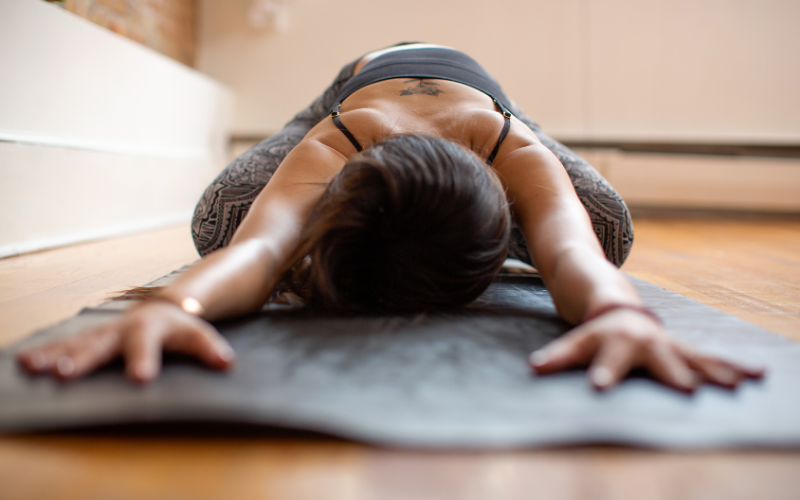EMDR Therapy and Yoga
Guest Blog Post by Madeline Vann, LPC, RYT200
Tell us a little about you, your experience becoming an EMDR therapist, and your experience with yoga as well.

I started yoga an undisclosed number of decades ago when I was in my 20s. Back then it was a way for me to manage the stress of my work—which was a completely different career. I was working in public relations for a training hospital/medical school with a level 1 trauma center. We were on the health and medical side, and it was fairly fast-paced. Years later, starting a new career, I had seen many benefits personally for yoga in my life that when I was doing my counseling training and had the opportunity to take yoga teacher training at the same time, I did so. Yoga teacher training did more for me in terms of learning how to manage time and be present for other people (especially in group work) than the formal counseling training did. From there, my counseling work and yoga practice evolved on parallel tracks, both leaning more toward understanding the polyvagal system and our nervous system. I did my EMDR training during the COVID years, and at that time I was also teaching yoga online. It felt like the whole world was on Zoom. EMDR and yoga inform each other in my work every day, especially when I am facilitating the visualizations and resourcing tools we use with EMDR.
We’ve seen the term ‘trauma-sensitive yoga.’ Can you help us understand more about this term, and what differentiates it from ‘regular yoga?’
I think ‘regular yoga’ is moving more in the direction of ‘trauma-sensitive yoga,’ but it was not always that way. There are whole books written about this topic.
The brief summary is that for many people in North America, yoga is a physical fitness workout. However, the teachings of yoga broadly speaking are more than that. Traditionally the word yoga is understood to be related to the word “yoke,” as in yoking together a person’s breath, mind, and body. In fact, what we usually think of as yoga—the asanas, or postures—are only a small part of yoga as a whole. Trauma-sensitive yoga takes a more holistic and spiritual view and considers all aspects of human well-being. I did the training in TC-TSY (Trauma Center Trauma Sensitive Yoga), which centers concepts such as choice-making and interoception as foundational to a yoga practice. In a ‘regular yoga’ class there might be an expectation that students have to do what the instructor says to do. In TC-TSY we make it clear that the people we are doing yoga with can choose to move any way they like, or not at all.
When I was in my original teacher training program, I was taught to be authoritative and not use phrasing like “maybe you want to move into this posture” but in trauma-sensitive yoga, we intentionally phrase the sequence as an invitation, not a command. I think this is also an important stance in EMDR – to give choice where we can. In yoga, we encourage paying attention interoceptively to how choice feels. Research suggests that this approach is as effective as other trauma therapies in reducing post-traumatic stress symptoms. Additionally, in a regular yoga class, teachers sometimes will put their hands on students to adjust their postures. In trauma-sensitive yoga, we would never do this for any number of reasons including the awareness that touch can be triggering for survivors and participants. A trauma-sensitive yoga class is typically more accessible for people with a range of body types and abilities, which can require a lot of knowledge and flexibility in a teacher. In a regular yoga class attendees often feel pressure to look and move in the same way as everyone else. Those are just a few of the differences.
How can EMDR therapy and yoga complement each other in treatment? What successes have you seen?
EMDR and yoga complement each other a great deal. In my experience, the greatest benefit might be for the EMDR therapist to have yoga as a tool for themselves to manage stress and vicarious trauma, and also because the knowledge of the body and the nervous system from yoga really can come in handy when sitting with someone in EMDR. For example, studying yoga often includes the study of breathing, which can be helpful for both therapist and client during reprocessing. Understanding how the body moves or wants to move can also be helpful throughout the 8 phases of EMDR therapy. When I was first thinking about this blog topic, a colleague mentioned that for her, the time when she sits down to write notes is when the full emotional content of the session hits the hardest. And that’s where a good seated yoga series (or other yoga series) could come in handy. I think that for me every time I help clients be more at home in their bodies, increase their nonjudgmental interception, and understand the power of choice-making, that is a win for EMDR therapy and yoga.
Are there any cautionary measures you would like to mention regarding using EMDR therapy and yoga?
I do have a couple of cautions which align with our professional ethical obligations for training. It is vitally important to complete yoga teacher training (at least 200 hours) and continue to get continuing education, in keeping with the expectations of the Yoga Alliance. Yoga teacher trainings have expanded my knowledge base and increased my respect for my fellow yoga teachers. They are often present as some of the most calm and soothing people you might ever meet; underneath that yoga teacher’s presence is a wealth of knowledge of anatomy, physiology, and creative problem-solving.
The other cautionary thought would be to bear in mind that while yoga especially talks a lot about the breath and breathing—sometimes in very controlled ways—breathing practices can be challenging for some of our trauma clients.
Are there any myths you’d like to bust about EMDR therapy and yoga?
There are so many. I think the biggest one that I encounter, which is true for both of them separately, is that they are a threat to people’s current faith traditions. Because I believe in choice-making, I would always give clients the option to opt-out, but I often also take time to reassure people that yoga and EMDR are not threats to an individual’s religion.
The second myth (which is maybe more of a wish) is that either EMDR or yoga is a miracle cure for the lasting impact of trauma. We practitioners know this is not so, but I do think both (together and separately) are held up as panaceas. Yoga in particular is a recommendation that is often made casually as something people in distress should be doing without consideration for people’s desire to do yoga, beliefs and fears about yoga, accessibility, and more.
What complexities or difficulties might people undergoing the integration of EMDR and yoga face? How does this affect therapy?
I often find myself forgetting that my clients and yoga students don’t have the experience I have with these approaches. So, they can be on a steep learning curve, which might be uncomfortable. One of the key concepts in yoga is that we grow at our edges, but that growth is uncomfortable. That is also sometimes part of the experience of EMDR therapy: growing at a person’s edge. We must remember to go slowly. Even with people who have prior experience with either or both modalities, there might be enough of a difference between their experience and what I am offering, that it becomes challenging.
I encourage people to get trained in yoga formally as part of their continuing education. The yoga teacher training I have done has benefited my personal and professional growth. However, getting formally trained in yoga also informed my outlook on safety. My 200-hour teacher training was amazing and also very rigorous. Some of the most compelling information our teachers shared with us was about the injuries that can occur when people aren’t guided in and out of yoga postures
What multicultural considerations might EMDR therapists need to keep in mind regarding EMDR therapy and yoga?
There are a number of considerations when assessing whether elements of yoga will work for a client. Therapists might want to reflect on issues such as whether a client’s faith or spiritual practice aligns with yoga, how a client’s cultural context aligns with yoga, and whether the words or phrases most often used in yoga instruction would be welcome. Sometimes this is a matter of vocabulary, for example offering a breathwork or mindful movement practice could be more acceptable than using terms such as pranayama (for breathwork) or asanas (for movement and posture practices).
What is your favorite free resource that you would suggest to other EMDR therapists interested in learning more about utilizing EMDR therapy and yoga?
I would encourage people to go to the Yoga Alliance (www.yogaalliance.org) and check out all the resources there. Also, look up Trauma Center Trauma Sensitive Yoga (https://www.traumasensitiveyoga.com/). The full training is costly, however there are scholarships and funding available. The first step would be to find a local facilitator offering an informational session.
I honestly don’t know of any formal resources combining yoga and EMDR therapy. The people I know who do it are just both trained as yoga teachers and also provide EMDR therapy, and let their yoga training inform the way they work with clients. I am a huge fan recently of the book “Polyvagal-Informed EMDR: A Neuro-Informed Approach to Healing“ by Rebecca Kase.
What would you like people outside the EMDR community to know about the use of EMDR therapy and yoga?
I think the most important thing people outside of the EMDR community should know is that people can suffer less from the past, and lean more into the life they deserve. EMDR therapy and yoga are both avenues toward those ends. In both cases, I would encourage shopping around to find therapists and/or yoga teachers or studios that are a good fit.
Anything else you’d like to add?
I’m just really grateful for the opportunity to share my passion for yoga and EMDR therapy. They have both transformed my work with clients. It is a privilege to sit and move with all of them.
Madeline Vann, LPC, CSAC, RYT200 is the Trauma Program Manager at The Farley Center in Williamsburg, Va, and also in private practice in Williamsburg. She focuses on trauma, grief, and addiction recovery in adults, specifically military, veterans, and first responder clients. Ms. Vann recently became EMDR Certified. She is the mother of four and spouse of a retired U.S. Navy veteran. She has also been in public health, journalism, and public relations fields before her current work.
References
Kase, R. (2023). Polyvagal-informed EMDR: A neuro-informed approach to healing. W. W. Norton & Company.
Schnur, O. (2021, September). Trauma-Sensitive Yoga: A Complementary Therapy for EMDR. Go With That Magazine, 26(3), 4-11.
Trauma Center Trauma Sensitive Yoga. Research & Studies/Resources. https://www.traumasensitiveyoga.com/research
Trauma Center Trauma Sensitive Yoga. Website. https://www.traumasensitiveyoga.com/
Yoga Alliance. Website. https://yogaalliance.org/
Back to Focal Point Blog Homepage
Additional Resources
If you are a therapist interested in the EMDR training:
- Learn more about EMDR therapy at the EMDRIA Library
- Learn more about EMDR Training
- Search for an EMDR Training Provider
- Check out our EMDR Training FAQ
If you are EMDR trained:
- Check out EMDRIA’s Let’s Talk EMDR Podcast
- Check out the EMDRIA Focal Point Blog
- Learn more about EMDRIA membership
- Search for EMDR Continuing Education opportunities
If you are an EMDRIA Member:
Date
February 21, 2025
Contributor(s)
Madeline Vann
Practice & Methods
Polyvagal, Your EMDR Practice





